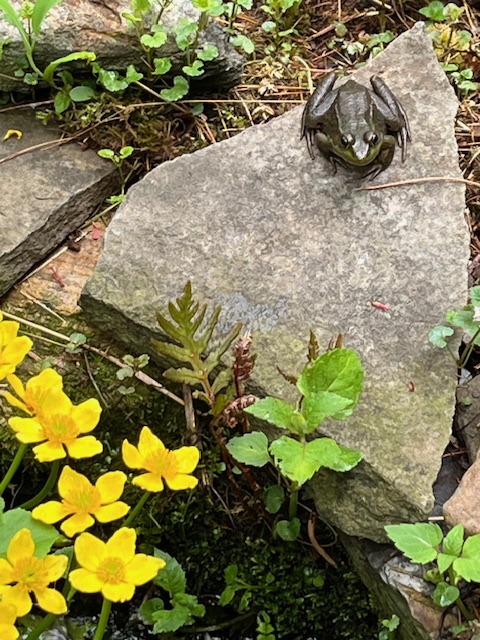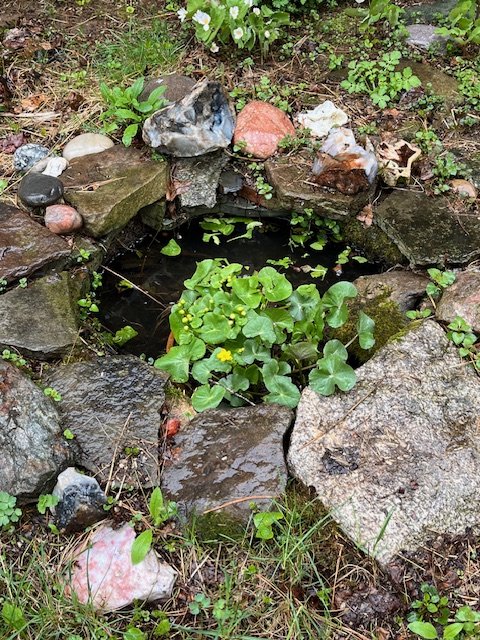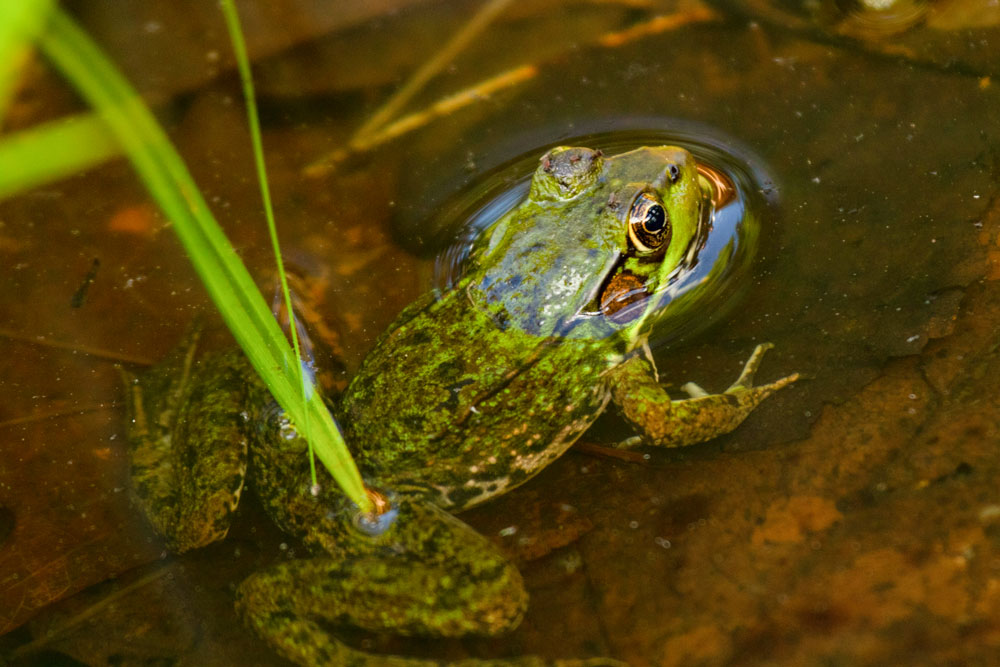Hunter and his Relatives – Green Frogs

Hunter at his pond
This morning Hunter leapt under towering marigold umbrellas into tadpoled pond water as I tore up another handful of spinach leaves to feed the wood-frog babies, the last I will be raising; they no longer breed here. Although I have raised little masked bandits for 40 years (2/3rds of the clutch I found never made it to the tadpole stage).
When Hunter moved in on May 11, I initially felt dismay. Green frogs do predate on wood frog tadpoles, so I was not overjoyed to see him. Normally green frogs don’t arrive here until the wood frog tadpoles have undergone their radical transformation in late June or early July.

Hunter’s pond
Green frogs are always friendly to those that appreciate them, and so despite his predatory character I quickly became attached to this frog who greeted me whenever I approached him (no this was not a warning call). Most mornings, I observed Hunter snapping up unwary insects from one of the circular stones that ring my little pool. Evenings, he hunted from an old log. For a while I kept checking on the tadpoles and if he has ever eaten any I can’t tell. Now (end of June) I have to part the greenery to visit with him. We communicate without words.

When Celeste arrived almost a month later the two struck up a friendship, each hunting from their favorite spot, or just sunning together from a rock. Some days I can’t see one or the other so both come and go. But apparently this habitat keeps drawing them back in… Meanwhile, in the last three days the wood-frog tadpoles are transforming into froglets and hopping into protective greenery (fernery) one by one. A poignant leave – taking for me.
In early June this year I found green frog egg clusters in one forested vernal pool that was fed by a seep, so technically this was not a pool but a fen. Next year, I think I’ll try raising these green frog tadpoles like I used to. I have been focusing on raising wood frogs because they are an indicator species, and I’ve known for years that they are disappearing.
Green Frogs (Lithobates clamitans) are aquatic amphibians who rarely wander far from some water source. Throughout their range, they are commonly found in marshes, creeks, fens, road-side ditches, swamps, brooks, moist woodlands, vernal pools, springs, and on the margins of freshwater ponds and lakes (they prefer shallow waters – bull frogs eat them).
Green frogs are about 2 to 4 inches long with greenish-brown coloration. They have large discs, called tympanums, behind each eye. Prominent ridges extend from these distinctive rounds down the length of their backs. Bullfrogs who also look similar when younger lack dorsolateral ridges, making it easier to distinguish green frogs from bullfrogs. Female green frogs can be or are larger than males (sources vary – my own experience suggests the females around here are larger), but males have larger tympanums and bright yellow throats. As tadpoles, green frogs are olive green with off-white bellies and spotted tails which makes it easy to distinguish them from others.
Green frogs are an ecotone species, meaning they inhabit the transition area between two biomes. Green frogs used to be found across most of the eastern United States, but of course habitat loss, polluted waters, climate change, damming etc. are reducing numbers.
Green frogs can swallow insects, spiders, fish, crayfish, shrimp, freshwater clams, other frogs, tadpoles, small snakes, and snails. I wonder if Hunter’s early appearance this year might be responsible for snail population control. I say that because last year I never had a green frog move in until the middle of August (the latest ever) and I had masses of baby snails. Tadpoles feed on algae, water plants and fresh spinach if provided! One interesting fact is that if these frogs live in larger ponds as eggs and tadpoles, they are toxic and generally unpalatable to fish, a great adaptation.
Green frogs overwinter in silt, under water or underground hibernating (called brumation) until early April. Most years the green frogs that spend the summer here are gone by the end of September.
They breed between June and September. Male green frogs call more frequently during the mating period. This calling becomes even more frequent if they have failed to mate between July and September. When selecting a mate, females take male size and territory into account. Larger males make calls with lower frequencies, which provides an indication of male body condition before females see them. Better quality male territories usually have more dense foliage, and larger males generally inhabit these territories more often than smaller males.
Male green frogs are aggressively territorial around mating season (I have never witnessed this behavior). Encounters usually start with intimidation in which a male defending its territory will display its bright yellow throat to deter approaching males. If an intruding male persists despite this warning, the two males grapple with each other for anywhere from a few minutes to almost an hour, until one surrenders and leaves the disputed territory. Other territory defense behaviors include kicking, biting, head-butting, and making aggressive calls that sound like growls! When mating the male uses his front legs to clasp the female’s body, causing her to release the eggs, which are fertilized externally. Breeding males can be recognized from the females by the swollen base of the thumbs and thick front legs that are used during amplexus.
Hunter and Celeste never laid eggs here this year, maybe because it’s too already too crowded or they aren’t sexually mature, or they traveled to another seep/marsh to breed on this property? Perhaps this pond simply isn’t big enough or it’s too early for these two. Mysteries, all. Hunter croaks, but only at me.
Females release up to 5,000 eggs in a film-like mass among the surface vegetation in shallow water. The eggs are black and surrounded by two clear, jelly-like envelopes. Under ideal circumstances they can hatch in a week. Earlier this month I visited one forested seep that had five clusters of green frog eggs floating near the surface. I returned three times in one week to check, and all but one clutch had hatched – the remaining mass didn’t hatch at all, it just disintegrated. Green frog tadpoles are dark green on the dorsal side of their bodies, with tails that are dark green or brown with dark spots. Their throats are white and the ventral side of their bodies white or cream. Some tadpoles hibernate for either one or two winters in silt or dead plant matter before becoming frogs ( the literature is contradictory with regard to this issue ). Sexual maturity occurs one or two years after reaching adulthood. Green frogs have a life span of up to about five years I am told.
Green frogs perceive colors and have excellent hearing. Their eyes are particularly sensitive to sunlight and moonlight allowing them to travel safely during the night, find prey, and new bodies of water. During rainy periods green frogs travel from their ‘homes’ to forage elsewhere. Around here there is so much wild foliage from my summer flower garden that they don’t have to go far to find a variety of new insects and other tasty morsels. I often meet one or two when I walk down to the brook but after I surprise them, they immediately disappear, making it almost impossible to photograph one.
Everyone loves to eat frogs. Bears, foxes, mink, weasels, herons, crows, raccoons, coyotes – the list is seemingly endless – and let’s not forget humans who feast upon their close relatives the bullfrogs.Earlier this month I spent part of another gorgeous buggy morning at a beaver dam in the woods. As I sat down to listen to a deafening gray tree frog and peeper symphony (it was hot) within seconds six green frogs popped into view only a foot or so away.
Animals know when we love them.
Great photos, Sara! Frogs are awesome. I hope that the very high heat in our area is not cooking them to extinction.
LikeLike
Oh, I hope not too… So hard on all the animals all these weather extremes – how are you managing? tried to reply to your post yesterday and was unable to – you should see my tadpoles they are getting back legs – getting ready to put them in an aquarium with land space – this is the tricky part – this transforming from water to land… think I have about a week.. my photos Tom are just taken with iPhone around here – so glad that you like them! means a lot -thanks
LikeLike